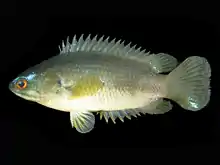Anabantiformes
The Anabantiformes /ænəˈbæntɪfɔːrmiːz/ are an order of freshwater ray-finned fish with two suborders, five families (Channidae, Aenigmachannidae, Anabantidae, Helostomatidae, and Osphronemidae) and having at least 207 species.[2] In addition, some authorities expand the order to include the suborder Nandoidei, which includes three families - the Nandidae, Badidae and Pristolepididae[3] - that appear to be closely related to the Anabantiformes. The order, and these three related families (classified as incertae sedis by the 5th edition of Fishes of the World), are part of a monophyletic clade which is a sister clade to the Ovalentaria, the other orders in the clade being Synbranchiformes, Carangiformes, Istiophoriformes and Pleuronectiformes. This clade is sometimes referred to as the Carangaria but is left unnamed and unranked in Fishes of the World.[2] This group of fish are found in Asia and Africa, with some species introduced in United States of America.
| Anabantiformes | |
|---|---|
 | |
| Climbing Perch (Anabas testudineus) | |
| Scientific classification | |
| Kingdom: | Animalia |
| Phylum: | Chordata |
| Class: | Actinopterygii |
| Clade: | Percomorpha |
| Order: | Anabantiformes Britz, 1995 |
| Suborders and Families[1] | |
|
see text | |
| Synonyms | |
| |
These fish are characterized by the presence of teeth on the parasphenoid.[2] The snakeheads and the anabantoids are united by the presence of the labyrinth organ, which is a highly folded suprabranchial accessory breathing organ. It is formed by vascularized expansion of the epibranchial bone of the first gill arch and used for respiration in air.[4][2]
Many species are popular as aquarium fish - the most notable are the Siamese fighting fish and several species of gouramies.[4] In addition to being aquarium fish, some of the larger anabantiforms (such as the giant gourami[5]) are also harvested for food in their native countries.[4][6]
Taxonomy
There are two suborders and five families currently recognized within the order Anabantiformes:[2][7][8][3][1][9]
- suborder Anabantoidei Berg, 1940
- family Anabantidae Bonaparte, 1831
- family Helostomatidae Gill, 1872
- family Osphronemidae van der Hoeven, 1832
- Subfamily Belontiinae (Liem, 1962)
- Subfamily Osphroneminae (van der Hoeven, 1832)
- Osphronemus (Lacepède, 1801)
- Subfamily Luciocephalinae (Bleeker, 1852)
- Luciocephalus (Bleeker, 1851)
- Sphaerichthys (Canestrini, 1860)
- Ctenops (McClelland, 1845)
- Parasphaerichthys (Prashad & Mukerji, 1929)
- Subfamily Macropodusinae (Hoedeman, 1948)
- Trichogaster (Bloch & Schneider, 1801)
- Trichopodus (Lacepède, 1801)
- Betta (Bleeker, 1850)
- Parosphromenus (Bleeker, 1877)
- Macropodus (Lacepède, 1801)
- Malpulutta (Deraniyagala, 1937)
- Pseudosphromenus (Bleeker, 1879)
- Trichopsis (Canestrini, 1860)
- suborder Channoidei Berg, 1940
- family Aenigmachannidae Britz et al., 2020
- Aenigmachanna (Britz, Anoop, Dahanukar and Raghavan, 2019)[9]
- family Channidae Fowler, 1934
- Parachanna (Teugels & Daget, 1984)
- Channa (Scopoli, 1777)
- family Aenigmachannidae Britz et al., 2020
Phylogeny
Below shows the phylogenetic relationships among the Anabantiform families after Collins et al. (2015), here including the Nandoidei as Anabantiforms:[3]
| Anabantiformes |
| |||||||||||||||||||||||||||||||||||||||||||||
References
- R. Betancur-Rodriguez, E. Wiley, N. Bailly, A. Acero, M. Miya, G. Lecointre, G. Ortí: Phylogenetic Classification of Bony Fishes – Version 4 (2016)
- J. S. Nelson; T. C. Grande; M. V. H. Wilson (2016). Fishes of the World (5th ed.). Wiley. p. 390. ISBN 978-1-118-34233-6.
- Collins, R.A.; Britz, R.; Rüber, L. (2015). "Phylogenetic systematics of leaffishes (Teleostei: Polycentridae, Nandidae)" (PDF). Journal of Zoological Systematics and Evolutionary Research. 53 (4): 259–272. doi:10.1111/jzs.12103.
- Pinter, H. (1986). Labyrinth Fish. Barron's Educational Series, Inc., ISBN 0-8120-5635-3
- Chanphong, Jitkasem. (1995). Diseases of Giant Gourami, Osphronemus goramy (Lacepede) Archived January 6, 2007, at the Wayback Machine. The Aquatic Animal Health Research Institute Newsletter 4(1).
- Froese, R.; D. Pauly (eds.). "Trichogaster trichopterus". FishBase. Retrieved 2006-12-23.
- Richard van der Laan; William N. Eschmeyer & Ronald Fricke (2014). "Family-group names of Recent fishes". Zootaxa. 3882 (2): 001–230.
- Karel F. Liem (1963). The comparative osteology and phylogeny of the Anabantoidei (Teleostei, Pisces). Illinois biological monographs. 30. Urbana,University of Illinois Press,1963.
- Raghavan, Rajeev; Dahanukar, Neelesh; Anoop, V. K.; Britz, Ralf (2019-05-09). "The subterranean Aenigmachanna gollum , a new genus and species of snakehead (Teleostei: Channidae) from Kerala, South India". Zootaxa. 4603 (2): 377–388. doi:10.11646/zootaxa.4603.2.10. ISSN 1175-5334. PMID 31717234.